Nursing Discussion Posts: Ethics, Vulnerability, and Patient Care
VerifiedAdded on 2022/12/27
|7
|1708
|1
Discussion Board Post
AI Summary
This document comprises four discussion posts addressing crucial aspects of nursing practice. The first post emphasizes the significance of patient education, highlighting the challenges nurses face in providing effective health information and suggesting methods to optimize patient literacy, including personalized approaches and the use of accessible language. The second post examines the American Nurses Credentialing Center's (ANCC) Magnet Recognition Program, outlining its framework for nursing practice, research, and its impact on healthcare outcomes, including improved nurse independence and patient care results. The third post delves into ethical considerations related to vulnerable populations in research, discussing the importance of distinguishing between research vulnerabilities and the need for legislative protection, along with issues in current regulations. The final post focuses on nursing ethics, underscoring the need for nurses to provide ethical care, considering patient values and cultural beliefs, and recognizing the influence of these factors on healthcare practices and patient outcomes. References are provided for each post.
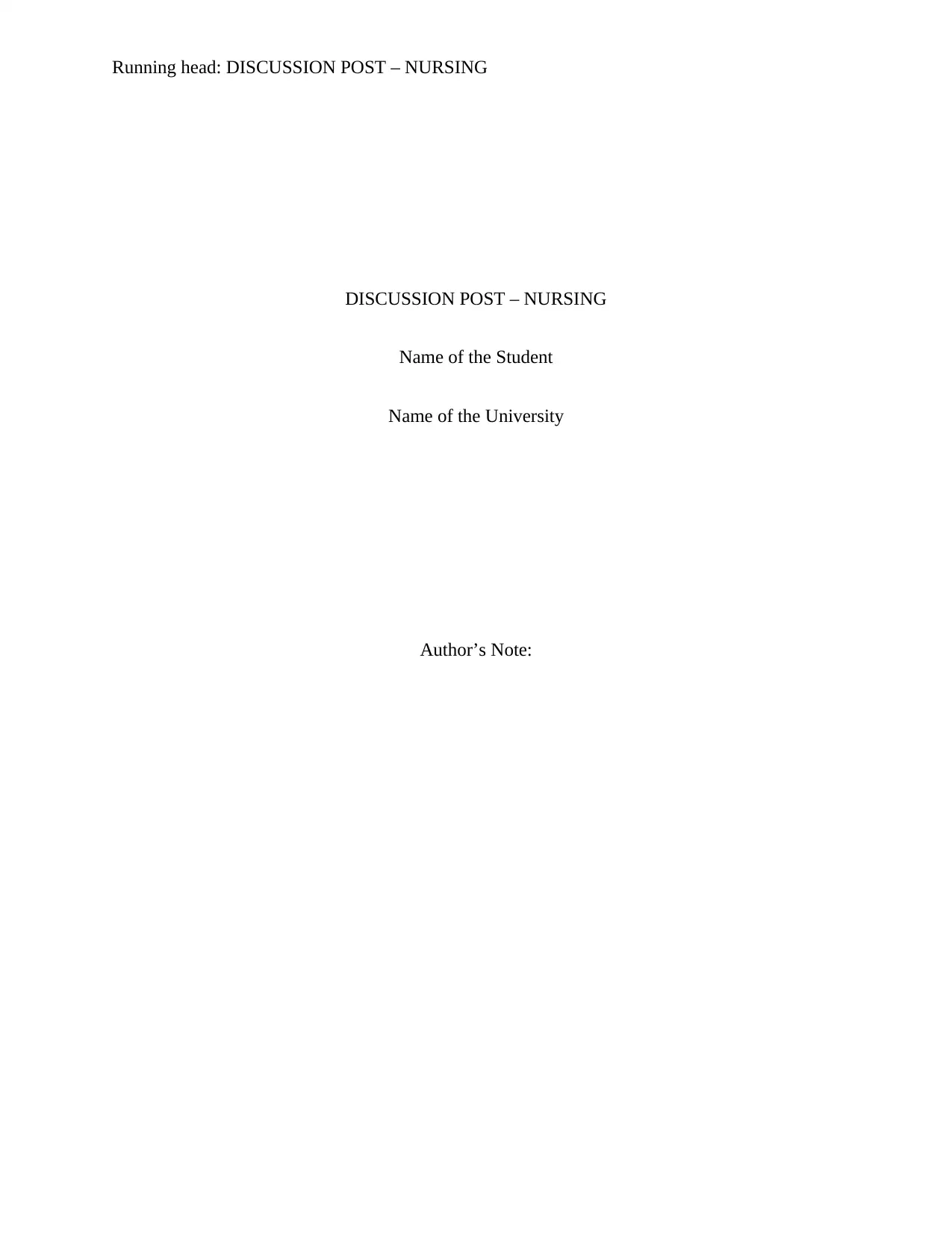
Running head: DISCUSSION POST – NURSING
DISCUSSION POST – NURSING
Name of the Student
Name of the University
Author’s Note:
DISCUSSION POST – NURSING
Name of the Student
Name of the University
Author’s Note:
Paraphrase This Document
Need a fresh take? Get an instant paraphrase of this document with our AI Paraphraser
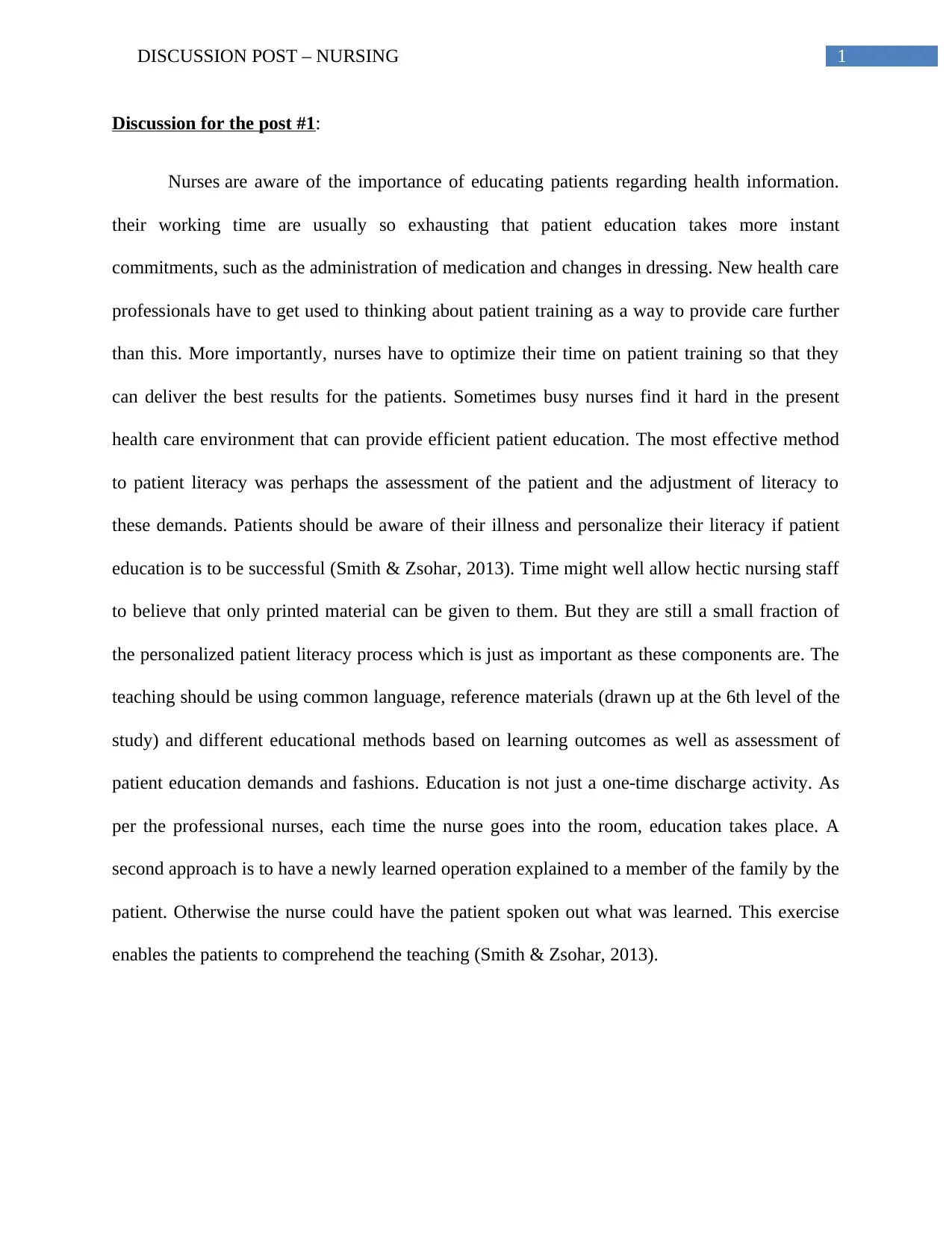
1DISCUSSION POST – NURSING
Discussion for the post #1:
Nurses are aware of the importance of educating patients regarding health information.
their working time are usually so exhausting that patient education takes more instant
commitments, such as the administration of medication and changes in dressing. New health care
professionals have to get used to thinking about patient training as a way to provide care further
than this. More importantly, nurses have to optimize their time on patient training so that they
can deliver the best results for the patients. Sometimes busy nurses find it hard in the present
health care environment that can provide efficient patient education. The most effective method
to patient literacy was perhaps the assessment of the patient and the adjustment of literacy to
these demands. Patients should be aware of their illness and personalize their literacy if patient
education is to be successful (Smith & Zsohar, 2013). Time might well allow hectic nursing staff
to believe that only printed material can be given to them. But they are still a small fraction of
the personalized patient literacy process which is just as important as these components are. The
teaching should be using common language, reference materials (drawn up at the 6th level of the
study) and different educational methods based on learning outcomes as well as assessment of
patient education demands and fashions. Education is not just a one-time discharge activity. As
per the professional nurses, each time the nurse goes into the room, education takes place. A
second approach is to have a newly learned operation explained to a member of the family by the
patient. Otherwise the nurse could have the patient spoken out what was learned. This exercise
enables the patients to comprehend the teaching (Smith & Zsohar, 2013).
Discussion for the post #1:
Nurses are aware of the importance of educating patients regarding health information.
their working time are usually so exhausting that patient education takes more instant
commitments, such as the administration of medication and changes in dressing. New health care
professionals have to get used to thinking about patient training as a way to provide care further
than this. More importantly, nurses have to optimize their time on patient training so that they
can deliver the best results for the patients. Sometimes busy nurses find it hard in the present
health care environment that can provide efficient patient education. The most effective method
to patient literacy was perhaps the assessment of the patient and the adjustment of literacy to
these demands. Patients should be aware of their illness and personalize their literacy if patient
education is to be successful (Smith & Zsohar, 2013). Time might well allow hectic nursing staff
to believe that only printed material can be given to them. But they are still a small fraction of
the personalized patient literacy process which is just as important as these components are. The
teaching should be using common language, reference materials (drawn up at the 6th level of the
study) and different educational methods based on learning outcomes as well as assessment of
patient education demands and fashions. Education is not just a one-time discharge activity. As
per the professional nurses, each time the nurse goes into the room, education takes place. A
second approach is to have a newly learned operation explained to a member of the family by the
patient. Otherwise the nurse could have the patient spoken out what was learned. This exercise
enables the patients to comprehend the teaching (Smith & Zsohar, 2013).
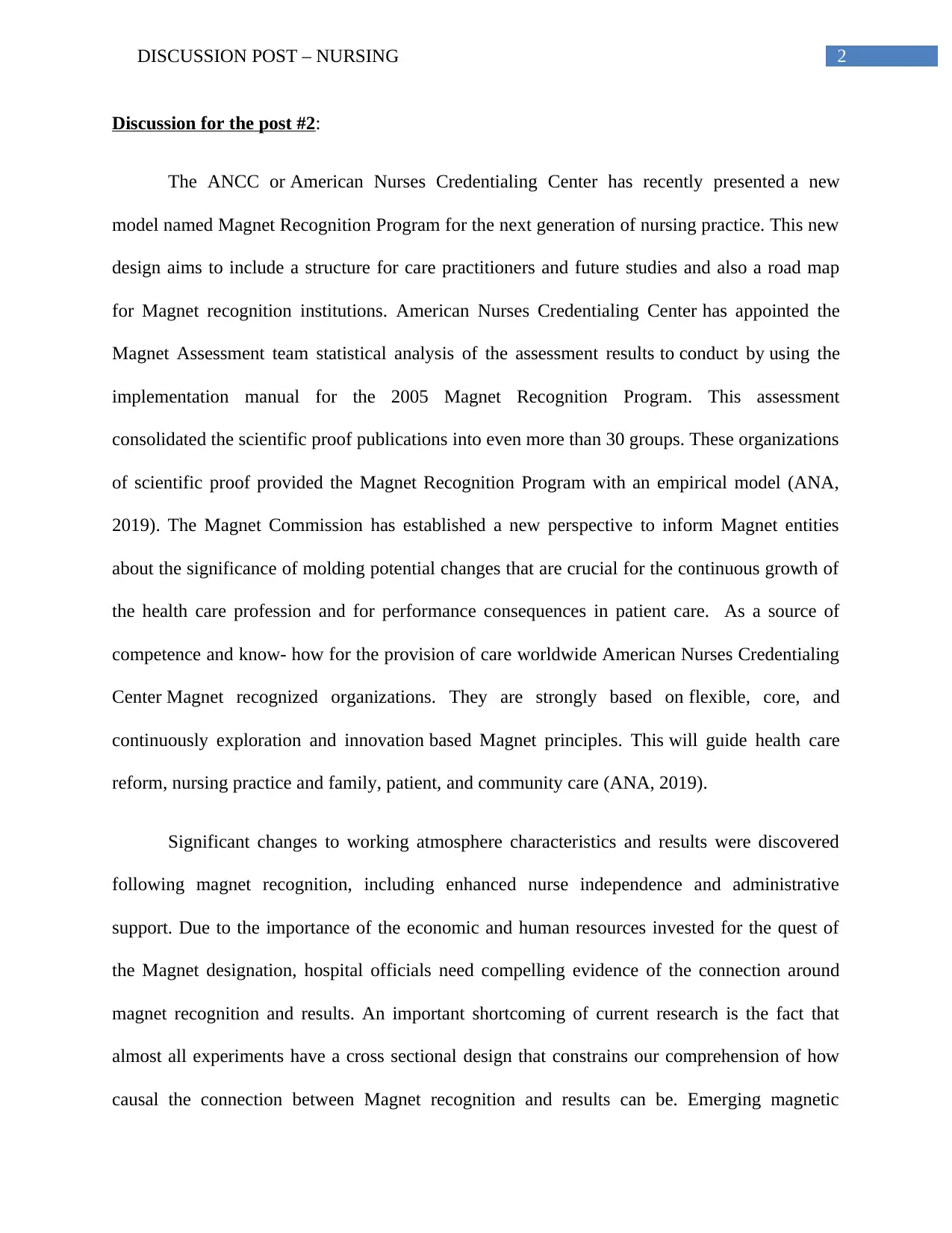
2DISCUSSION POST – NURSING
Discussion for the post #2:
The ANCC or American Nurses Credentialing Center has recently presented a new
model named Magnet Recognition Program for the next generation of nursing practice. This new
design aims to include a structure for care practitioners and future studies and also a road map
for Magnet recognition institutions. American Nurses Credentialing Center has appointed the
Magnet Assessment team statistical analysis of the assessment results to conduct by using the
implementation manual for the 2005 Magnet Recognition Program. This assessment
consolidated the scientific proof publications into even more than 30 groups. These organizations
of scientific proof provided the Magnet Recognition Program with an empirical model (ANA,
2019). The Magnet Commission has established a new perspective to inform Magnet entities
about the significance of molding potential changes that are crucial for the continuous growth of
the health care profession and for performance consequences in patient care. As a source of
competence and know- how for the provision of care worldwide American Nurses Credentialing
Center Magnet recognized organizations. They are strongly based on flexible, core, and
continuously exploration and innovation based Magnet principles. This will guide health care
reform, nursing practice and family, patient, and community care (ANA, 2019).
Significant changes to working atmosphere characteristics and results were discovered
following magnet recognition, including enhanced nurse independence and administrative
support. Due to the importance of the economic and human resources invested for the quest of
the Magnet designation, hospital officials need compelling evidence of the connection around
magnet recognition and results. An important shortcoming of current research is the fact that
almost all experiments have a cross sectional design that constrains our comprehension of how
causal the connection between Magnet recognition and results can be. Emerging magnetic
Discussion for the post #2:
The ANCC or American Nurses Credentialing Center has recently presented a new
model named Magnet Recognition Program for the next generation of nursing practice. This new
design aims to include a structure for care practitioners and future studies and also a road map
for Magnet recognition institutions. American Nurses Credentialing Center has appointed the
Magnet Assessment team statistical analysis of the assessment results to conduct by using the
implementation manual for the 2005 Magnet Recognition Program. This assessment
consolidated the scientific proof publications into even more than 30 groups. These organizations
of scientific proof provided the Magnet Recognition Program with an empirical model (ANA,
2019). The Magnet Commission has established a new perspective to inform Magnet entities
about the significance of molding potential changes that are crucial for the continuous growth of
the health care profession and for performance consequences in patient care. As a source of
competence and know- how for the provision of care worldwide American Nurses Credentialing
Center Magnet recognized organizations. They are strongly based on flexible, core, and
continuously exploration and innovation based Magnet principles. This will guide health care
reform, nursing practice and family, patient, and community care (ANA, 2019).
Significant changes to working atmosphere characteristics and results were discovered
following magnet recognition, including enhanced nurse independence and administrative
support. Due to the importance of the economic and human resources invested for the quest of
the Magnet designation, hospital officials need compelling evidence of the connection around
magnet recognition and results. An important shortcoming of current research is the fact that
almost all experiments have a cross sectional design that constrains our comprehension of how
causal the connection between Magnet recognition and results can be. Emerging magnetic
⊘ This is a preview!⊘
Do you want full access?
Subscribe today to unlock all pages.

Trusted by 1+ million students worldwide

3DISCUSSION POST – NURSING
hospitals have dramatically improved patient and care results over time compared with non-
magnet hospitals (Kutney-Lee et al., 2015). Generally, magnet acknowledgement is an
involvement that can lead to improved nursing outcomes and better patient outcomes. The
findings can partly have been accomplished in the studies of medical facilities that receive
magnet status because their nursing atmosphere has improved significantly. In Magnet medical
facilities, advancements were much more prominent than non-Magnets to certain elements of the
nurses ' workplace environment, including collaboration around nurses and doctors, involvement
in nursing care in hospital administration and sufficient resources (Kutney-Lee et al., 2015).
Discussion for the post #3:
Present philosophy of clinical practice are based on a basic assumption that certain
groups of people are supposed to be wronged, misused or used as research respondents more
likely than others. These groups are considered' vulnerable,' an identity which creates a
responsibility for providing special consideration for academics, review committee members and
regulators. When it has been acknowledged that within a specific population like economically
disadvantaged, people from other countries, the minority or groups with impairments or strong
hierarchical pressures, there is a presence of research fragility or abuse risk and it often becomes
clear in these populations (Solomon, 2013). With researchers continuing to recognize more
situations and people susceptible to research abuses, distinguishing between research
deficiencies in particular and research vulnerabilities requiring extra legislative protection which
is becoming extremely important. The otherwise tenuous research equilibrium between honoring
independence and safeguarding those that cannot safeguard them is threatened by overly easy
confusion of research vulnerabilities and increasing protection. The concept of appreciation for
individuals is therefore split into two distinct moral criteria: the autonomy requirement and
hospitals have dramatically improved patient and care results over time compared with non-
magnet hospitals (Kutney-Lee et al., 2015). Generally, magnet acknowledgement is an
involvement that can lead to improved nursing outcomes and better patient outcomes. The
findings can partly have been accomplished in the studies of medical facilities that receive
magnet status because their nursing atmosphere has improved significantly. In Magnet medical
facilities, advancements were much more prominent than non-Magnets to certain elements of the
nurses ' workplace environment, including collaboration around nurses and doctors, involvement
in nursing care in hospital administration and sufficient resources (Kutney-Lee et al., 2015).
Discussion for the post #3:
Present philosophy of clinical practice are based on a basic assumption that certain
groups of people are supposed to be wronged, misused or used as research respondents more
likely than others. These groups are considered' vulnerable,' an identity which creates a
responsibility for providing special consideration for academics, review committee members and
regulators. When it has been acknowledged that within a specific population like economically
disadvantaged, people from other countries, the minority or groups with impairments or strong
hierarchical pressures, there is a presence of research fragility or abuse risk and it often becomes
clear in these populations (Solomon, 2013). With researchers continuing to recognize more
situations and people susceptible to research abuses, distinguishing between research
deficiencies in particular and research vulnerabilities requiring extra legislative protection which
is becoming extremely important. The otherwise tenuous research equilibrium between honoring
independence and safeguarding those that cannot safeguard them is threatened by overly easy
confusion of research vulnerabilities and increasing protection. The concept of appreciation for
individuals is therefore split into two distinct moral criteria: the autonomy requirement and
Paraphrase This Document
Need a fresh take? Get an instant paraphrase of this document with our AI Paraphraser
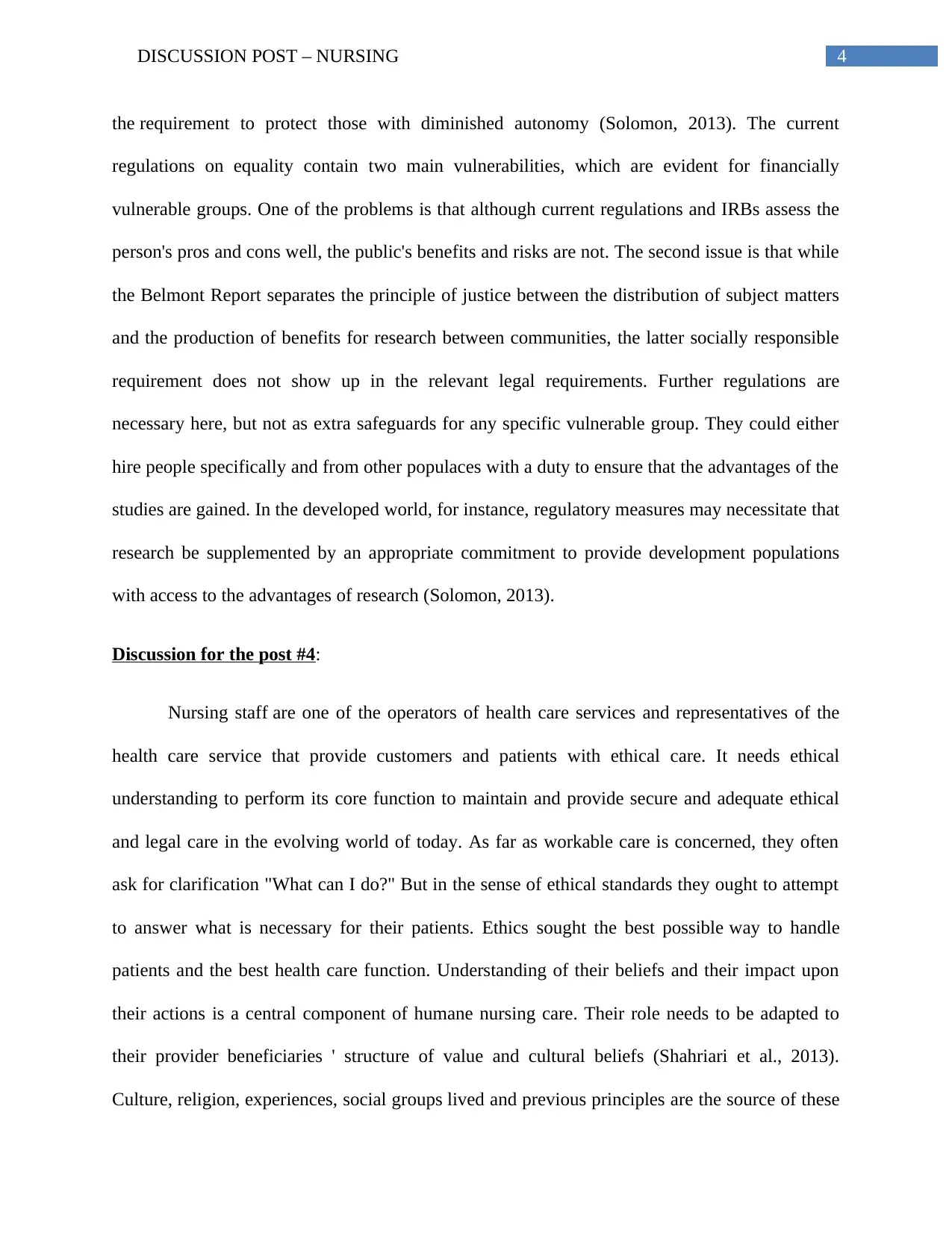
4DISCUSSION POST – NURSING
the requirement to protect those with diminished autonomy (Solomon, 2013). The current
regulations on equality contain two main vulnerabilities, which are evident for financially
vulnerable groups. One of the problems is that although current regulations and IRBs assess the
person's pros and cons well, the public's benefits and risks are not. The second issue is that while
the Belmont Report separates the principle of justice between the distribution of subject matters
and the production of benefits for research between communities, the latter socially responsible
requirement does not show up in the relevant legal requirements. Further regulations are
necessary here, but not as extra safeguards for any specific vulnerable group. They could either
hire people specifically and from other populaces with a duty to ensure that the advantages of the
studies are gained. In the developed world, for instance, regulatory measures may necessitate that
research be supplemented by an appropriate commitment to provide development populations
with access to the advantages of research (Solomon, 2013).
Discussion for the post #4:
Nursing staff are one of the operators of health care services and representatives of the
health care service that provide customers and patients with ethical care. It needs ethical
understanding to perform its core function to maintain and provide secure and adequate ethical
and legal care in the evolving world of today. As far as workable care is concerned, they often
ask for clarification "What can I do?" But in the sense of ethical standards they ought to attempt
to answer what is necessary for their patients. Ethics sought the best possible way to handle
patients and the best health care function. Understanding of their beliefs and their impact upon
their actions is a central component of humane nursing care. Their role needs to be adapted to
their provider beneficiaries ' structure of value and cultural beliefs (Shahriari et al., 2013).
Culture, religion, experiences, social groups lived and previous principles are the source of these
the requirement to protect those with diminished autonomy (Solomon, 2013). The current
regulations on equality contain two main vulnerabilities, which are evident for financially
vulnerable groups. One of the problems is that although current regulations and IRBs assess the
person's pros and cons well, the public's benefits and risks are not. The second issue is that while
the Belmont Report separates the principle of justice between the distribution of subject matters
and the production of benefits for research between communities, the latter socially responsible
requirement does not show up in the relevant legal requirements. Further regulations are
necessary here, but not as extra safeguards for any specific vulnerable group. They could either
hire people specifically and from other populaces with a duty to ensure that the advantages of the
studies are gained. In the developed world, for instance, regulatory measures may necessitate that
research be supplemented by an appropriate commitment to provide development populations
with access to the advantages of research (Solomon, 2013).
Discussion for the post #4:
Nursing staff are one of the operators of health care services and representatives of the
health care service that provide customers and patients with ethical care. It needs ethical
understanding to perform its core function to maintain and provide secure and adequate ethical
and legal care in the evolving world of today. As far as workable care is concerned, they often
ask for clarification "What can I do?" But in the sense of ethical standards they ought to attempt
to answer what is necessary for their patients. Ethics sought the best possible way to handle
patients and the best health care function. Understanding of their beliefs and their impact upon
their actions is a central component of humane nursing care. Their role needs to be adapted to
their provider beneficiaries ' structure of value and cultural beliefs (Shahriari et al., 2013).
Culture, religion, experiences, social groups lived and previous principles are the source of these
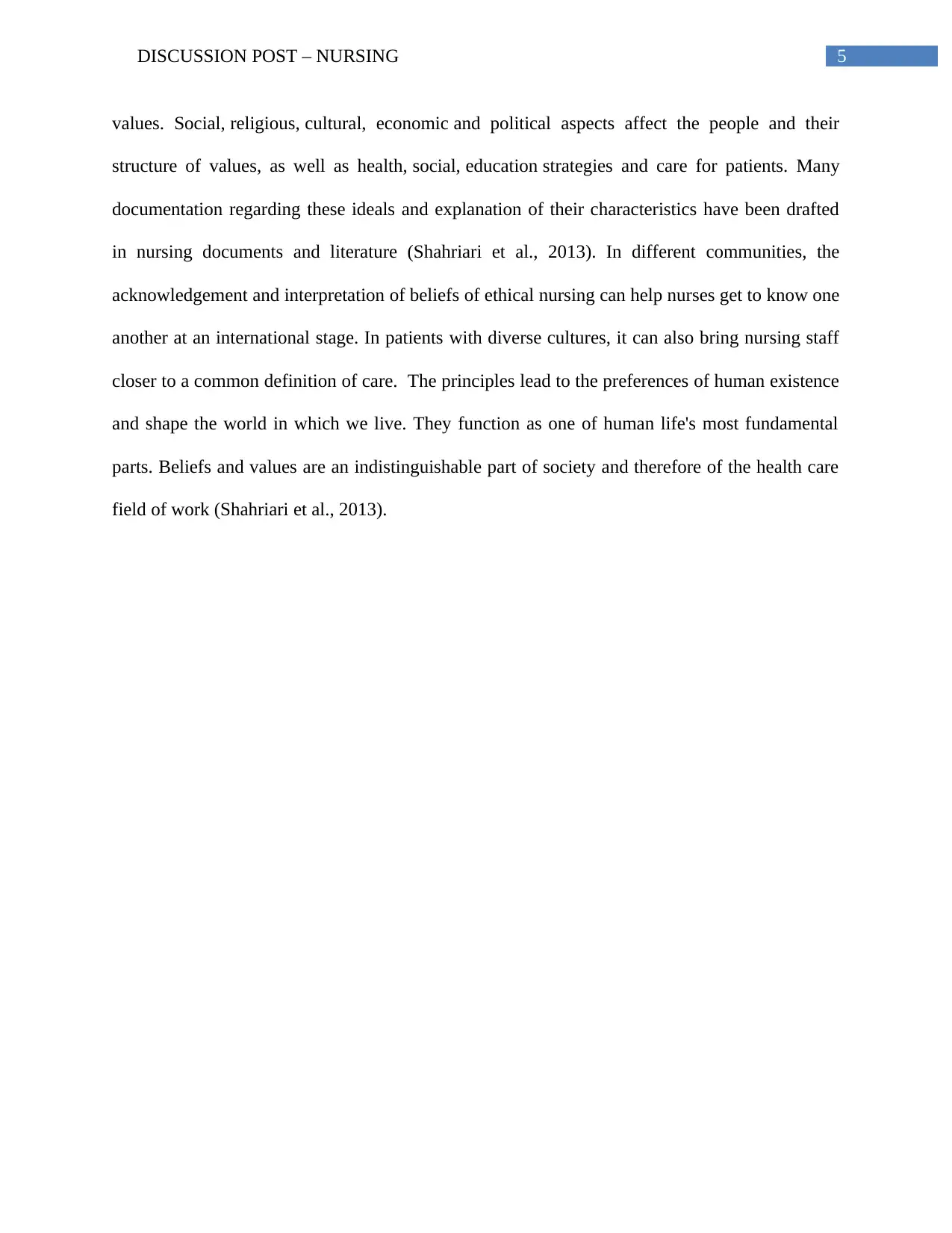
5DISCUSSION POST – NURSING
values. Social, religious, cultural, economic and political aspects affect the people and their
structure of values, as well as health, social, education strategies and care for patients. Many
documentation regarding these ideals and explanation of their characteristics have been drafted
in nursing documents and literature (Shahriari et al., 2013). In different communities, the
acknowledgement and interpretation of beliefs of ethical nursing can help nurses get to know one
another at an international stage. In patients with diverse cultures, it can also bring nursing staff
closer to a common definition of care. The principles lead to the preferences of human existence
and shape the world in which we live. They function as one of human life's most fundamental
parts. Beliefs and values are an indistinguishable part of society and therefore of the health care
field of work (Shahriari et al., 2013).
values. Social, religious, cultural, economic and political aspects affect the people and their
structure of values, as well as health, social, education strategies and care for patients. Many
documentation regarding these ideals and explanation of their characteristics have been drafted
in nursing documents and literature (Shahriari et al., 2013). In different communities, the
acknowledgement and interpretation of beliefs of ethical nursing can help nurses get to know one
another at an international stage. In patients with diverse cultures, it can also bring nursing staff
closer to a common definition of care. The principles lead to the preferences of human existence
and shape the world in which we live. They function as one of human life's most fundamental
parts. Beliefs and values are an indistinguishable part of society and therefore of the health care
field of work (Shahriari et al., 2013).
⊘ This is a preview!⊘
Do you want full access?
Subscribe today to unlock all pages.

Trusted by 1+ million students worldwide
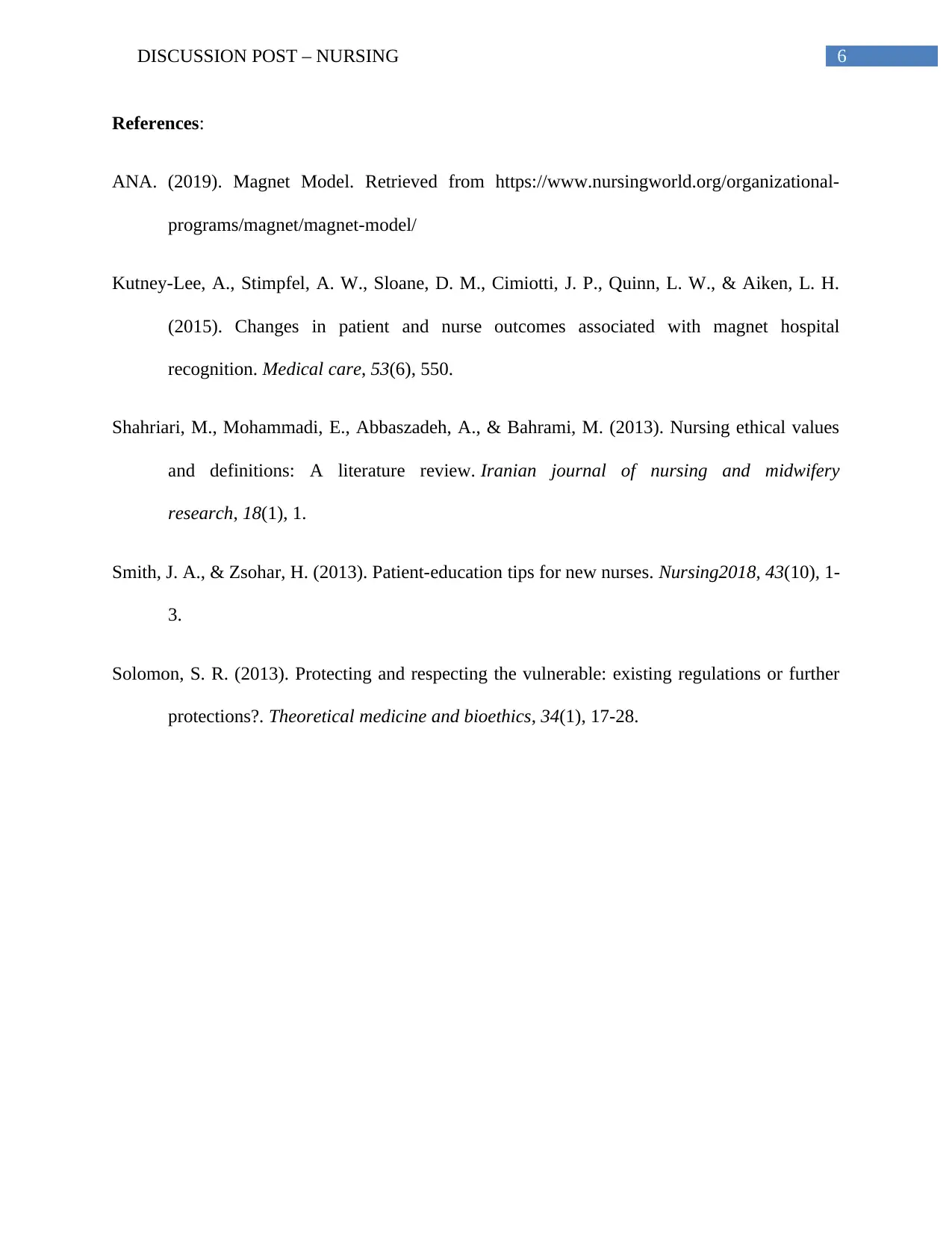
6DISCUSSION POST – NURSING
References:
ANA. (2019). Magnet Model. Retrieved from https://www.nursingworld.org/organizational-
programs/magnet/magnet-model/
Kutney-Lee, A., Stimpfel, A. W., Sloane, D. M., Cimiotti, J. P., Quinn, L. W., & Aiken, L. H.
(2015). Changes in patient and nurse outcomes associated with magnet hospital
recognition. Medical care, 53(6), 550.
Shahriari, M., Mohammadi, E., Abbaszadeh, A., & Bahrami, M. (2013). Nursing ethical values
and definitions: A literature review. Iranian journal of nursing and midwifery
research, 18(1), 1.
Smith, J. A., & Zsohar, H. (2013). Patient-education tips for new nurses. Nursing2018, 43(10), 1-
3.
Solomon, S. R. (2013). Protecting and respecting the vulnerable: existing regulations or further
protections?. Theoretical medicine and bioethics, 34(1), 17-28.
References:
ANA. (2019). Magnet Model. Retrieved from https://www.nursingworld.org/organizational-
programs/magnet/magnet-model/
Kutney-Lee, A., Stimpfel, A. W., Sloane, D. M., Cimiotti, J. P., Quinn, L. W., & Aiken, L. H.
(2015). Changes in patient and nurse outcomes associated with magnet hospital
recognition. Medical care, 53(6), 550.
Shahriari, M., Mohammadi, E., Abbaszadeh, A., & Bahrami, M. (2013). Nursing ethical values
and definitions: A literature review. Iranian journal of nursing and midwifery
research, 18(1), 1.
Smith, J. A., & Zsohar, H. (2013). Patient-education tips for new nurses. Nursing2018, 43(10), 1-
3.
Solomon, S. R. (2013). Protecting and respecting the vulnerable: existing regulations or further
protections?. Theoretical medicine and bioethics, 34(1), 17-28.
1 out of 7
Related Documents
Your All-in-One AI-Powered Toolkit for Academic Success.
+13062052269
info@desklib.com
Available 24*7 on WhatsApp / Email
![[object Object]](/_next/static/media/star-bottom.7253800d.svg)
Unlock your academic potential
Copyright © 2020–2025 A2Z Services. All Rights Reserved. Developed and managed by ZUCOL.





